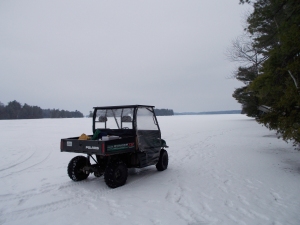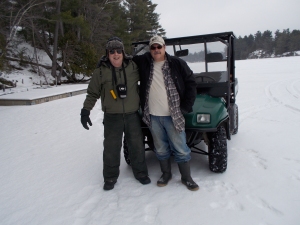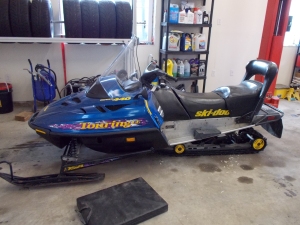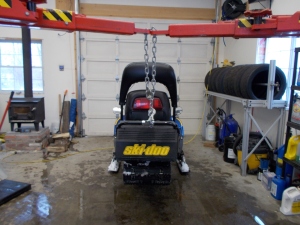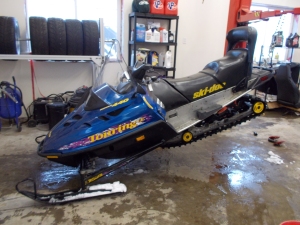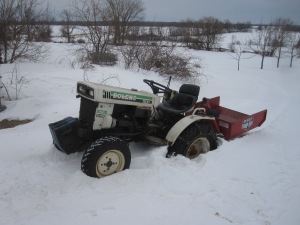Woodlot excursion
December 25, 2016
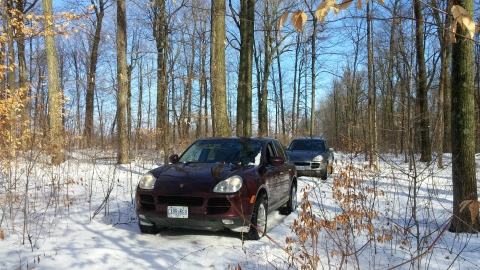
Over the years it has become a Christmas ritual to tour the woodlot by whatever means necessary. Ten years ago Charlie and Shiva began the tradition by bullying the golf cart into the trip through too much fluffy snow. When the Ranger replaced the golf cart, it hauled passengers and their snowshoes across the windy fields to the woodlot and froze them on the return trip.
This year Charlie started up both 2004 Cayennes to try out their low range and differential locks around the yard. Ruby was thus already cleaned off and warmed up when I grabbed my keys and tracked him down on the property. Then we toured the sugar bush.
We soon observed that it would take a good deal of snow to stop a Porsche Cayenne equipped with winter tires. I did manage to twist over an earth berm at such an angle that I needed to use the locker to maintain traction to the wheels, but Ruby felt right at home off-roading in snow.
The only problem is that puttering through the woods in a Porsche Cayenne isn’t much fun. It’s far too capable a vehicle. A golf cart or 2WD UTV, or even a snowmobile, provides much more of a challenge, and hence a higher fun quotient.
On the other hand Charlie is now a father and I’m not getting any younger, and we did break a good wide walking track through the bush.
Tom just told me that this won’t work as a title because nobody wants to hear about the trip unless it gets screwed up or we have bad luck.
But how about a couple of geezers defying the law on a back-roads tour to Newboro in a UTV? And then bouncing over drifts for three miles each way across the lake in a crude vehicle without working cup holders?
Or letting each other drive? Neither of us is much of a passenger.
I should mention that for winter I have enclosed the cabin of the Ranger so that the only exit is from the driver’s side. Last fall Tom gave me a piece of left-over boat-canopy plastic which had become translucent from age, but when I fitted it with pipe clamps where the right door would normally go, it kept the wind out quite well. There was just the problem of a little bit of claustrophobia for whoever’s riding shotgun.
Anyway, the rig is pretty warm in a cold wind, so for his annual winter expedition to the cottage I suggested to Tom that he would feel more comfortable and likely safer in the Ranger cabin rather than perched on the back of my Ski-Doo. The only trouble was that we would have to drive back roads to Newboro as the plastic windshields and improvised side tarp wouldn’t withstand a ride at highway speeds on a trailer. We’d have to drive seven miles of back roads to get to the lake.
I expected Tom would be fine without a means of escape from the Ranger until we got onto the ice, but it turned out my friend’s heart-stopping moments began as soon as we headed down the shoulder of the first paved road. I’d forgotten how spooky a ditch can look when one is perched above it on an icy shoulder. It’s hard to trust the left tires to maintain traction while the rights are sliding on glare ice. That metal cabin frame is reassuring when overhanging branches loom up on a trail, but the same metal seems less friendly when one thinks of banging into it with his head during a roll-over.
That’s what the seat belts are for, Tom.
Down the back roads we sped, cruising along at the Ranger’s full 24 miles per hour and letting on we were driving a Miata. A noisy Miata. The enclosed cabin keeps a lot of noise in, making it especially hard for the passenger to hear.
Tom played tourist, fascinated by our neighbours’ pristine stone house and property. He wondered about the missing windows from a brick porch on another, then he discovered the old cheese factory just off the Narrows Lock Road. We slipped into Newboro and changed drivers.
Now it was my turn for claustrophobia, as I decided that Tom would be less nervous on the ice with a steering wheel in hand. Of course that meant I’d be unable to bail out in an emergency. But I had brought along an escape tool, one of those padded hammers with a cutter built in. I rehearsed the routine: plunge the point through the vinyl, cut a big hole, then bail out, every man for himself. But in the meantime don’t let Tom get the Ranger stuck!
Trouble was that Tom couldn’t really hear my shouted instructions as to route selection because of the noise and the fuzzy earmuffs on his trapper hat. Fortunately Tony was running his 4WD Ranger ahead of us and I knew he would pick a clear route through the drifts. He learned his lesson last winter after twice belly-hanging the UTV on large patches of deep snow, the first time without a shovel aboard.
The ice is thick this year and quite predictable — as long as you don’t look at it. If you do try to find a way through the sea of small drifts by eye, though, the bare spots are terrifying. They look like open water.
Tom’s naturally a cautious driver, and when he’s not sure of his course he slows down. To his credit he didn’t spin the Ranger out for all of his drift-hopping while I screamed at him to keep his speed up.
In fact between us we managed to turn the voyage across Newboro Lake into an uneventful drive, if we don’t count a strained vocal cord on my part.
BTW: Two minutes before this photo was taken Tony was all neatly buttoned up into a sensible parka, but I think he was going for a contrast with Tom’s many layers of clothing.
Why Not IV: Miscellaneous adjustments
January 17, 2015
The Ski Doo’s engine now runs very well. I measured 14 miles per Imperial gallon on a refill after 81 miles of jackrabbit hops around the farm and neighbourhood. Starting is no longer an issue.
But the steering had begun to give me fits. Things were loose, but the catch was the effort required to maintain control while driving among the ruts of other machines. My son pointed out a loose ball joint on the steering linkage. It snugged up nicely with a 17 mm socket and 13 mm wrench.
But the steering was still much too vague. This morning I figured out a way to lift the front of the Ski Doo with the car hoist so that I could examine the steering linkage at my leisure. The central bolt proved loose. A few more turns with the 18 mm socket did the job. The skis no longer seemed cross-eyed.
A run down the Cataraqui trail went considerably better than before.
Another pair of riders stopped for a chat. One guy suggested double carbides to eliminate the wandering in ruts: the extra carbide selects its own lane.
On Newboro Lake the machine proved that its engine is strong and quick, hitting 50 m/hr on crusted snow without effort.
Why Not? III: re-learning the snowmobile
January 10, 2015
The sofa feels pretty good after this morning’s session with 450 pounds of aluminum and rubber attached to my ankle.
It may not have been as drastic as all that, but I did manage to tumble off the machine when I dumbly tried to climb an interesting set of drifts without adequate forethought. The machine ran out of momentum and I tipped off to the downhill side. One of my over-sized insulated rubber boots didn’t free itself from the stirrup and there I was. The boot soon came free, but I found myself stuck in my own back forty.
Then I remembered a video series where these guys from Ottawa ram snowmobiles through impossible conditions on a trip north. One of the topics was how to unstick a snowmobile. So I stamped down the snow on the uphill side of the machine and around the back. Of course I was getting wet because there hadn’t been much reason to put on snowmobile pants for a run around the farm.
The machine dutifully backed out of the trap. I remounted, remembered to balance the thing, and blasted up the hill over the remaining drifts. I stopped at the top, breathing pretty hard, but no more than I would lifting a large round of maple onto the block splitter.
Lesson relearned: every time you start a snowmobile it’s game on, and you had better be ready for whatever the trail can throw at you. Quietly I felt grateful for the week of wood-cutting I had gotten in after the recent thaw. It left me moderately prepared for unexpected exertions.
But it would be to oversimplify the tale if the prequel to this misadventure weren’t told. After Cory Sly rebuilt its carburetors I test-drove the 1999 SkiDoo Touring LE last night for a half hour. Apart from its tendency to fight the ruts on the Forfar section of the Cataraqui Trail, the machine ran perfectly.
This morning it started dutifully, but then the oil light winked on. I shut off. Restarted. Definitely on. This light indicates* that no oil is getting to the engine to mix with the gasoline.
Into the house, laptop open, crash course on oil injection systems in Ski Doo models. Posted a plea for help online, complained by email to pals. Before taking wrench to engine, though, I called Cory.
“It’s not an oil shortage. The light comes on when it’s a litre down to warn you to add more.”
“It’s full, and I backed the top off to let air in.”
“Is the parking brake on?”
“Uh, yeah?”
“You shouldn’t leave it on. It may stick on and you’ll end up with a hydraulic leak and hot pads, a recipe for a fire. Shut the parking brake off and it should be fine.”
And it was. Of course then I had to send more emails and Internet posts admitting my newbie jitters.
Then came the ride around the property, the wonderful new drifts, and a return to the couch to compose this account.
At the current rate it will be a long time before I log significant mileage on the snowmobile, but so far it appears willing.
* (among other things, it turns out)
Why not?
December 8, 2014
It’s a 1999 (technically a classic) so it qualifies for the cut-rate trail pass. Insurance isn’t bad, and there was so much snow last March we couldn’t move from the driveway. I chose to frame the purchase as the reaction of a rational man to last winter’s claustrophobia.
10 December, 2014, 9:37 p.m.
It’s impossible to state how much snow there is outside as it’s all drifts and bare gravel on the way to my equipment shed. Suffice it that there’ll be snow in the fields for the Ski-Doo tomorrow.
Today I bought a trail pass online. Now I have to wait until they send the sticker to me, but the Ministry of Snowmobile Trails hasn’t opened them yet, anyway.
11 December, 2014
The recently-purchased Ski-Doo’s o.k. I’ve had a bit of trouble starting it when cold due to flooding. Maybe I’ll try without the choke next cold start.
The ’99 Touring LE offers an excellent ride with good steering which allowed me to follow paths through the woodlot without difficulty. This stands in sharp contrast to the behaviour of its predecessor, a ’76 Alpine, whose single ski worked more to separate the saplings for the massive, pointed bumper than it did to direct the sled. I had found it dangerous to sit on the Alpine’s seat when hurdling drifts, as the landings sometimes compressed one’s spine in a shocking manner. The long-legged Touring acts as though it would prefer a 20-mile run on packed trails to a poke around the sugar bush. It certainly shows more power than I’ll need in the woodlot.
This anti-Alpine will no doubt show its shortcomings in future rides, but for now I like the easy steering and cushy ride.
13 December, 2014
Apart from the use of a spark plug wrench to start the machine in the morning, it works very well. I’m studying everything written on the subject and watching every video even tangentally related to Ski Doo carburetor problems. Some headway has been detected.
The 13.6 mile tour took me across our fields to Forfar, through “town” on asphalt, then onto the Cataraqui Trail, across Hwy 15, and ending at Little Lake, a large pond accessible only by snowmobile.
The skis occasionally ground against coarse gravel on the old railway bed, but the machine’s ride reminded me far more of a Lexus sedan than an off-road vehicle. The hand and thumb warmers quickly warmed up digits frozen on that spark plug wrench.
I discovered that 25 mph is plenty fast enough on a straight, graded snowmobile trail at this time of year. 35 mph is marginally acceptable along a familiar path on a large field.
But the ’99 Ski Doo Touring is surprisingly competent and easy to drive. This has never been more apparent than when I tried to reverse my course. I turned off the trail onto an upward-sloping driveway, then reversed downhill. Starting off on the slope offered a whiff of warm drive belt, but the long sled turned as easily as an SUV and we were on our way home without fuss. A similar move with the intractable ’76 Alpine would have required considerable effort.
A cold start this afternoon brought the machine to life without the use of the spark plug ratchet, so I may yet learn how to operate this promising addition to the Young’s Hill motor pool.
14 December, 2014
This morning’s start with 1/2 choke didn’t work after a 2 second attempt, so I released the choke and rolled it with open throttle for a couple of 5 second bursts until it started. As usual, the engine performed flawlessly, once started.
The Ski Doo passed a milestone this morning when I climbed on behind my fishing buddy Tony for a spin around the field. Online advice had it that the machine was too light for anyone over 200 pounds, though it had seemed pretty good over rough fields with just me aboard. This test was with two passengers, combining considerably more weight than the sled’s modest 440 pounds. The ride was fine. It didn’t respond as readily to steering inputs as with a single rider, but handling was certainly controllable enough for an occasional ice fishing expedition.
Observing the machine in operation from a distance, I was amazed at its quiet. The more we drive it, the better it seems to run.
Next step: installing the hitch and modifying the snowmobile sled we found in the barn to carry a power ice auger and fishing tackle.
15 December, 2014
Today I put a fire on in the shop and attended to some of the maintenance tips I gleaned yesterday from a variety of online sources. First was the new belt, which went on easily with the tool I found in the carefully-packed tool case. The old belt’s still in good condition, so I stashed it under the rear seat.
The gear case dip stick had a few filings on its magnet, but the oil looked good, was at the correct level, and I saw no evidence of leaking below.
The main task was to grease the underpinnings, those unmentionable parts only a stern list of must-do’s could make me examine. The manual said to roll the machine onto its side… Uh, I stood on the edge of the running board and pulled on the handle bar, but it didn’t tip, just slammed its left ski down on the shop floor.
Further examination revealed a broken case for the right mirror: I’ll bet I know how that happened. With no desire to do further damage to the rather pristine coachwork on the Touring, I opted to use the system I developed for the 5′ mid-mount mower on my Kubota. The auto lift had no trouble with the weight, and I found three of the (alleged) four fittings under the track. The four fittings on the steering loosened up the my grease gun, and then I let loose with rustproofing oil on the various metal-to-metal moving parts.
The suspension immediately felt less notchy, and we glided fluidly over the local bumps as I put the machine away. Interestingly, the rear bumper now sits at 16″. Before the grease it sat at 17 1/2″.
Over the day I’ve learned that if 1/2 choke doesn’t start the engine, a second or two on the starter with the throttle open will do the job. At least at the freezing point.
There’s a good chance the starting problem is with the operator, not the machine.
UPDATE: 30 March, 2015
The starting problems ended when Cory Sly replaced the float valves in the carburetors (under warranty). From then on the engine started and ran very well. It logged about 300 miles on short runs around the property and a few local trail rides.
Fording with a Lexus ES 330
April 13, 2014
It was a placid Sunday drive to check out a new kennel where our spaniel could enjoy her vacation while we went on ours. The navigation system directed us to the Narrows Lock Road and away we went. Then we came to a stretch of asphalt which seemed to be below water level for about two hundred yards.
Orange cones denoted the entrance on both sides, but there was no ROAD CLOSED sign such as the one I encountered last week on my way home from Chaffey’s Locks.
Realizing that we both had our rubber boots on for the kennel visit, I stopped the car and waded out half-way. It was borderline. My feet weren’t in danger of getting wet, but there was quite a bit of water above the yellow line painted on the asphalt below.
So we started off, slowly wading the low sedan through the calm water. This went well enough. I watched the floor and nothing was leaking in. Then the pavement broke up. This was a surprise. It had looked smooth from the top, but the drive was becoming very lumpy. But there was no going back now, so with memories of that floating Ferrari on the Don Valley Parkway last summer, we headed slowly for the other side.
As we emerged, flashers flashing, a woman in a new Ford pickup ignored my warning and blasted through the whole thing, throwing a bow wake like a Quebec cabin cruiser on a holiday weekend.
Oh, well.
A low-speed chase:
April 4, 2014
Rod, I’ve noticed when reading your blog that you have a fascination for 4 wheeled machinery of all shapes and sizes with tractors high on your list. I draw to your attention the article in the Globe today page A3 by Carrie Tait which covers the RCMP — 5 members — chasing a robbery suspect during a prolonged chase with the suspect evading capture by snowmobile, then a Rhino and finally, and I suspect your favourite, a John Deere 6400 tractor. This story is just made for you!
Cheers, George Kitching
It was -10C this morning with an icy north wind. The snow crunched like midwinter’s when I stepped on it. O.K., I was bored. I had fired up Tony’s 4WD Polaris Ranger to take out the garbage and it made sense to warm it up a bit before putting it back in the shed. And there was that huge expanse of untraveled snow…
The Ranger booted over the snowbank at the edge of the driveway and dove down behind the house. No problem. If it can do this, I can haul the sugar-making equipment up to the shack. How do I get back up? Last year I ran on down the hill, crossed to the barnyard and climbed back up the hill there.
Off I went at full speed. The snow felt like concrete under the freshly-tuned Ranger’s wheels. I carved a wide turn in the 20-acre field below the house and headed west. This was too much fun. Why not carry on to the other end, another quarter-mile away, and come back the next field over?
At cruising speed I ducked through the gap between fields. A straight shot to the 50 acres beyond beckoned, so I headed north.
All of the sudden the left front wheel of the Ranger dove into deep snow, quickly followed by the rest of the 1500 pounds of vehicle, cargo and driver.
Why is it always the left side which falls through the crust? Tony has a real stability problem with that machine.
Mind you, my slightly lighter Ranger TM did the same thing in January. In fact the only way three of us could keep the 1100 pound vehicle on the crust after lifting it up and rolling it ahead was to drive it from outside, manipulating the gas pedal with an old canoe paddle found in the box. Maybe it’s the driver’s weight that’s the problem. Oh, well.
So there Tony’s Ranger sits, front corner down in two feet of snow, next to a quiet farm lane. It’s comfortable. There’s no point abusing it in a frantic attempt to back out. A crew will either lift it back up onto the snow or spring will free it, whichever comes first.
https://www.flickr.com/photos/112002166@N06/13428228334/
UPDATE: 6:50 p.m.
Did I mention I buried the winch tractor on the way back to rescue the Ranger? I explained to Bet that I had needed some space in the buildings for sugar-making equipment. This barely earned the derisive grunt it received.
After supper I walked back to the Ranger with a round-point shovel. Anything I dug just buried it deeper.
On the other hand the Massey Ferguson 35, though apparently stuck in the snow, wasn’t quite done yet. After rocking a bit of a gap, I discovered that while high speeds were useless against the crumbling snow, if I eased the old tractor forward very slowly it would in fact climb back up onto the crust and creep the final 150 yards to where I could turn it downhill and run the cable 150′ to the Ranger. That was 5800 pounds + driver riding on the crust at least a foot above the field.
The buried Ranger offered no resistance whatever to the 8800 lb winch. In no time it was back up on the crust and after a couple of spins around the fields to celebrate and allow the battery to charge up, I put it away. The MF35’s as comfortable there as anywhere.
UPDATE: 27 March, 2014, 5:30 p.m.
It only gets worse. I need spring to get here.
UPDATE: 30 March, 7:30 p.m.
After a day of thaw I was able to drive the winch tractor from where I had abandoned it to a road a half-mile away. With the winch I then rescued the Bolens by dragging it through three feet or more of snow to a path I had blown out with another tractor.
We still can’t get to the sugar bush with wheeled implements, snowshoeing has become an agonizing way to travel now with the uncertain footing, but the thaw is gaining momentum.
UPDATE, 3 April, 2014:
Rod vs Snow
So far it’s Snow 6, Rod 0.
The path back to the woods remains stubbornly impassable for wheeled vehicles. There’s just too much snow and with mud underneath. The task overwhelms even my larger tractors. The situation improves each day, but only by a little.
Four days ago on snowshoes I sank to the bottom so drastically that I could barely travel. In one area in the middle of the walnut field I dropped into snow above my knees. Sore muscles leave me disinclined to try that again soon.
But waiting for spring is a difficult concept even for a not-so-young fellow hardly brimming with energy, not to mention a son whose travel agenda allows only a short time in which to expose all of his friends to the joys of sugar making.
Of course the trees in the lane (now 33 buckets) have stopped running. Yesterday I tried to use the new Kubota with its large turf tires to smooth the ruts in the driveway. Nearly got the thing stuck. With a trailer attached it’s useless in mud.
Today is another day. It’s frozen quite hard outside this morning, so the sap may run. The tractor may even make it from the big walnut tree (a quarter-mile back the lane) across the 450′ of walnut seedlings to the woodlot, where more deep snow awaits. Then at least the Ranger will be able to haul people and materials back and forth to the house.
Saturday, 5 April, 2010
We’re still far from our goal of free passage to the woodlot, though it rained heavily overnight. At 6:00 a.m. on Charlie’s last weekend before he returns to Vancouver, who knows how today will unfold?
Review: Kubota B7510 tractor (UPDATED)
May 18, 2013
I’ve spent the better part of the last week getting adjusted to the 2005 Kubota B7510 I purchased privately last weekend and trailered home. So here are some notes and a few questions. Please jump in with a comment where you have information to ad.
Towing
A few years ago I built a tandem trailer for my Polaris Ranger and usually tow it with a 4 cylinder, 4WD Toyota Tacoma, rated for 3500 pounds. The truck/trailer combination proved marginal at best for hauling a B7510 with belly mower. In hilly country I was genuinely worried about the rig’s stopping ability on the wet pavement of the day. For another trip of that duration (3 1/2 hours, one way) I will use a heavier vehicle and a trailer with brakes.
Mid-mount Mower
It’s quite an impressive implement. I spent the better part of two days on a flat garage floor adjusting the thing for a tall cut. It produces a fine mowed surface now, and the rocks are well below the cutters (ok, most of them). The vendor installed the mower by driving over it and clicking everything into place. It took him about ten minutes. To remove the MMM I slid it sideways on the garage floor. Because the mower was set to a 3 1/2″ setting, though, it lacked the clearance underneath. A floor jack raised the front enough to allow the belly mower to slide out to the right. A pair of link stoppers underneath (small plates to hold the mower arms when the mower’s not installed) proved crumbled by the hoist, so I had to remove one and take it to an anvil. The other I beat into place with a small ball-peen hammer. To hop forward in the chronology, after I had re-installed the mower and raised it once, the link stoppers were crumbled yet again. This time I removed both after a look in the manual. The problem was at the setup stage: heavy steel cotter pins were driven through the shaft retaining the link stoppers, and their bulk restricted the necessary rotation of the bits which are designed to clip onto other pins to keep them out of the way of harm from the mower mechanism. Out of curiosity I checked a 2011 B3000 at a local soccer field. Its link stoppers are also bent, caused again by too-thick steel cotter pins restricting the movement. To replace the mid-mount mower the manual calls for it to be set to the lowest possible setting. I didn’t want to do that and planned to store the MMM in a gravel-floored building, so I resolved to dig the mower into the gravel, provide appropriate blocks, and lighten the front wheels of the tractor by not removing the 405 lb. rotary mower from the 3 pt hitch. Then I removed the two flimsy metal covers on the top and drove over the MMM as the vendor had demonstrated. He was a bit better at it, but the process worked. UPDATE, OCTOBER, 2013: Turns out the best way to access the mid-mount mower is to raise the front of the tractor by chain from the car hoist. I use a choke chain off my timber skidder looped through the ends of the rear lift arms. It’s efficient and safe as long as I don’t hit my head on heavy metal while working.
Seat and seat belt
It’s impossible to mow without the seat belt fastened. Perhaps the tractor is designed that way. The seat is slippery enough I would fall off it on some of the slopes of our lawn, and without the down-force of the belt the tractor could easily flip me from the seat on full-speed, 400′ dashes to the end of the lawn. For the record, in light grass the mower cuts very well at max. cruising speed. The mower is indeed an impressive implement. UPDATE: I paid a lot of money for a new seat the parts guy and I found at the Kubota dealer. Enough’s enough. The hated original seat was actually the subject of an exchange program from Kubota a few years ago.
4WD
The extra wheels driving make treacherous slopes easy on this machine. That said, in one terraced section I did use the differential lock to get up over the top. The drive train provides seamless power in tough going, though to eliminate skid marks on corners I have learned to mow in 2WD much more frequently than I did with the Bolens. To its credit the G174 has very effective differentials, and skid marks on the lawn were never a problem until the Kubota took over.
Hoist
Is there any way to adjust things so that the mower doesn’t trail along on its front casters while lifted? (UPDATE, June 13, 2013: The centre roller is digging in on slopes because it can’t rotate around its shaft. It’s pinned in place by the hardware which trails from the front to the mower. Doesn’t seem adjustable. Must ponder this.) UPDATE: The parts guy suggested disassembling the centre roller and lubricating it carefully. Now it turns well but still digs ruts where the mower would otherwise high-centre.
Remotes
I switched the ends to fit my log splitter and tried it. Not bad at all. The splitter seems just as fast (not very) as when mounted on my 35 hp. TAFE, maybe a bit faster. My line pressure gauge reads 2600, which seems high. I tried to adjust the nut. The lock nut came loose easily, but the inner nut seemed to be soldered to the larger round end on the housing. Is the whole thing supposed to turn? I put all of the force I judged appropriate onto the end of a 9/16″ wrench and nothing moved. Perplexed. UPDATE, May 29, 2013: Embarrassed grin. When my neighbour Peter Myers dropped by I asked him about the adjustment. He looked and immediately noticed that the inside of the thing adjusts with an Allen key. A quick 1/4 turn and the pressure was at 1950 lb. and all was well. He further told me that the only thing the high pressure would damage would be a weak hose.
The Tractor
It runs very well, produces an excellent cut when mowing, maneuvers easily, provides great visibility, reasonable comfort, and an improved level of operator safety (I hope) over my elderly Bolens G174. But I still like the Bolens better. I almost never smell exhaust fumes from the Bolens, and I just like the feel/sound of the two cylinder engine better than the rather loud Kubota mill when it’s running the mower. The Bolens is a friend; the Kubota is a tractor. Now when I drive the Bolens I am very conscious of its apparent tippiness. While the ‘Bota has done all of the mowing since its arrival, both lawn and tree plantation (with 48″ rotary mower), the Bolens is still very handy for odd jobs. I don’t see selling it. Another job for the G174: I figured with the empty 3 pt hitch on the Kubota I could easily use the trailer hitch triangle to ferry trailers around the yard when mowing. But I find myself using the Bolens for the job instead. The Kubota’s range of travel on the 3 pt hitch is restricted by the MMM hardware, so it won’t reach down far enough to pick low-lying trailer couplers up off the ground. With unlimited height adjustment, the Bolens works better for this. It also turns out it’s a lot easier for me to turn and look backwards from the Bolens seat, unencumbered by seat, belt, ROPS, and hydraulic controls mounted at my right elbow on the Kubota. So ease of turning around in the seat and the ability to reach down trumps the step-through frame, HST and power steering when jockeying trailers. So far.
Mowing under apple trees
Forget it. It’s too tall. The Roll Over Protection System stands 75″ from the ground. To mow around the trees this time I pressed the old mowers into service to do the precise job for which I bought the new one. But I’m still glad I bought the Kubota. You just never know how something new will get used until it’s been around for a while. Seems there’s still a role for the Simplicity riding mower. With its hydro drive and small stature I can insinuate it under the pear trees with minimal damage to the branches. Its engine is on its last legs, but may last a long time if it only does 20 minutes of work per week. As my neighbours all keep telling me, you can’t have too many tractors.
A final word about the use of a rotary mower with the B7510
I have spent 500+ hours operating a succession of rotary mowers on various tractors since retiring to the farm in 2004. Precise height control on the 3 pt hitch is highly desirable, though not essential. The Massey Ferguson 35’s control was pretty good. The TAFE’s isn’t bad, though it often conflicts with the loader on the other end. For mowing season I bolt the lower setting down quite rigidly and then it cuts very well with a 5′ Rhino mower. The Bolens G174 does not have height control. The Woods 3 pt hitch finish mower which came with it uses chains attached from the leading edge of the mower to the tractor end of the top link for a minimum-height stop. Correctly adjusted, these chains do a good job of regulating the cut. They are particularly useful when the operator has to lift the cutter over an obstacle and then resume. What the 2005 Kubota B7510 lacks which I understand the new models have is precise height control. I’ve now trimmed around ten acres of trees with it and it has done a very good job, but I have to reset the height by trial and error every time I move it. This is an area for improvement. I may steal the check chain brackets off the top-link of the Bolens and install them on the comparable shaft on the Kubota. If anyone knows of a vendor for these simple Woods chain plates (check chain bracket, part #23898) stamped out of 1/4″ steel, I’d like an additional pair. Kurt at Steensma Lawn and Power Equipment in Kalamazoo, MI was happy to take my order for the parts.
Update, 6 January, 2014
The B7510 starts pretty well in winter. Frigid conditions required a block heater. The local dealer provided one which replaced a twist-in plug on the side of the engine block. Note that Kubota calls for very long (to me) preheating intervals. My Massey Ferguson and TAFE both need just ten seconds to preheat, but a Kubota needs upwards of a minute in cold weather, and 20 seconds at a minimum. 15W40 non-synthetic oil works fine in winter, as well.
Update, 2 January, 2016
The Kubota’s ease of winter starting contrasts sharply to the Bolens G174’s cold-bloodedness. Despite the rudimentary heating element glued to its crankcase, if I wish to use the Bolens in very cold weather I have to put it to bed each night beside the stove in my woodworking shop. It’s a garage queen from ice-in until ice-out.
A false economy 24 April, 2015
When I bought the tractor it was missing one cap on its battery, the hole covered with duct tape. By the time I replaced the tape with a plug borrowed from a Polaris battery, spilled acid had rusted the cooling tubes and radiator screen. Two years later I found myself with a set of HST cooling tubes glowing orange from rust. This required a thorough cleaning and paint job on the affected area. The replacement battery only cost $89.00 from the dealer and works much better than the 10 year-old leaker in front of the fan. Why had I waited this long to replace it?
A surprise: the engine needs far less pre-heating with the new battery. The thing had started well all winter, so I hadn’t suspected that the 10 year-old battery was losing its touch (apart from leaking acid out the top, of course).
Safe when others must operate it 2 December, 2017
Heart surgery slowed me down last summer. Running the Kubota was more than I could handle, so my wife decided to mow what parts of the 2 acres of rolling lawns that she could. Turns out she did most of the mowing over the summer and rather enjoyed her new gardening implement. A retired electrician returned a decade of favours by stopping by to do whatever climbing and heavy lifting required. He lifted the 5 gallon cans of diesel to fuel the Kubota and mowed under the apple trees on the steep slope. Bet did most of the rest.
Nobody removed the mower for service, though, so it went almost 200 hours without grease or sharpening. In the fall my wife even mowed 1-mile trails through the fields and woodlot so that I would have a good surface for the walks which were part of the post-surgery therapy. When I finally cleaned it up and greased the mower, it seemed not to have suffered for the neglect.
Yesterday we pressed the Kubota into service to power a medium-sized logging winch. While I did not need to skid logs with the tractor, just control the felling of a bunch of dead trees, it carried the 540 lb. weight and, with the blade of the winch dug into soft ground, had lots of pull. The B7510’s a little light for the job, as a couple of hard pulls to control the fall of tall, crooked trees produced 4 wheel wheelies. Nonetheless, the Kubota did the job safely in a pinch, without damage to anything. The short length was a real asset in this thickly forested area. Again the safety interlocks on the tractor made it safer for a visiting operator to run it.
UPDATE, 29 December, 2018
At well over 800 hours now, the Kubota has proven to be by far the most useful tractor in the shed. Its recent implements include the 7.5 kw generator, a lightweight chipper, the lawn rake and the sweeper, and occasional bouts on the snow blower, winch, and box blade. Last summer I actually had to repair it. The tachometer cable failed. The local dealer had one for $35, though I had to dislodge a mouse nest in the dash to effect the repair.
